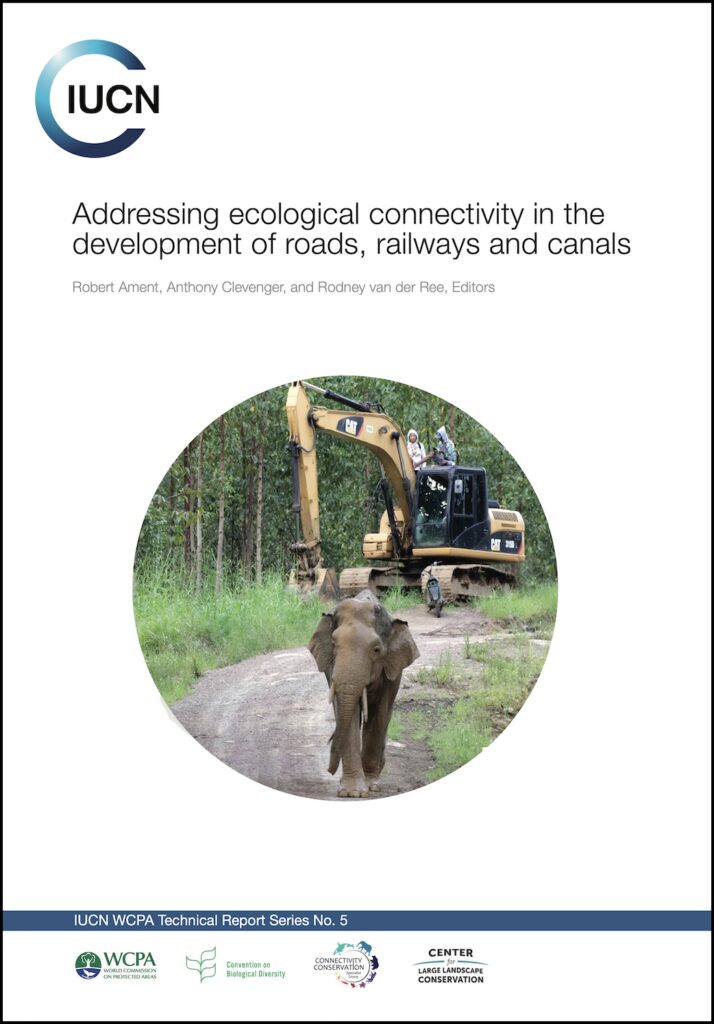Addressing ecological connectivity in the development of roads, railways and canals
Just Published!
The unprecedented rate of linear transport infrastructure (LTI) development such as roads, railways and canals is a key driver of global biodiversity decline. Direct impacts have been documented around the world: primarily habitat degradation, fragmentation and loss, direct species mortality, and the creation of physical barriers and filters to wildlife movement and ecological flows. In addition, other impacts can occur, such as pollution due to noise, light, vibration and chemicals, air and water quality degradation, the spread of invasive alien species and changes in hydrology and microclimate. Protected areas and other effective area-based conservation measures can face severe impacts to their ecosystems, species, and habitats with the expansion within or nearby of linear transport infrastructure.
As more intact areas with high environmental, biodiversity and ecological connectivity values become more accessible, an assortment of indirect problems can arise, including increased rates of hunting and poaching of wildlife; illegal mining, logging, and other extractive industries; increased frequency and intensity of wildfires; land speculation and illegal settlement. Addressing these direct and indirect impacts will require much more attention, increased technical skills and a better trained workforce as the demand for LTI grows precipitously around the world, especially in developing countries of Africa, Asia, and South America.
Ambitious economic and social development programs can generate large LTI investments to give communities better access to services, markets, and resources. These projects either expand the size and volume of existing linear infrastructure or are constructed in previously undeveloped, intact landscapes, often of high conservation value. Without proper safeguards for biodiversity and ecological connectivity, given the present speed and scale of expansion, there lies a high potential to unravel the progress made over the past five decades to designate, design, and manage PCAs embedded in ecological networks. Thus, the future will require planners and decision-makers to strike a balance between the anticipated socio-economic benefits of LTI with the challenges of safeguarding healthy ecosystems, ecological connectivity, and biodiversity.
The purpose of this WCPA Technical Report, ‘Addressing ecological connectivity in the development of roads, railways and canals,’ is to provide an overview of practical, feasible science-based strategies for PCA managers, transport practitioners, industry, conservationists, and other interested stakeholders. It introduces and describes the numerous solutions that are available to support biodiversity and ecological connectivity conservation in, and adjacent to, PCAs. It promotes best practices and provides details for the various phases of infrastructure development: planning, design, construction, operations, and monitoring.
This is the first IUCN publication to examine this topic in this context, and is intended to increase awareness and inspire commitment, the allocation of resources, good governance, and effective policies. Combined, these actions will contribute to more successful conservation, sustainable livelihoods, and resilient landscapes. Overall, this report identifies effective solutions that can be used in a variety of contexts around the world to better address ecological connectivity when developing LTI in and adjacent to PCAs.
Over the course of nearly four years, the Transport Working Group worked to develop this groundbreaking contribution to the IUCN WCPA Technical Report Series. The report, which benefited from contributions from more than 30 experts from around the world, was released in July of 2023.
Webinar
Hosted by the IUCN-WCPA Connectivity Conservation Specialist Group and its Transport Working Group, this webinar on February 27, 2024 introduced the Technical Report ‘Addressing ecological connectivity in the development of roads, railways and canals.’
Banner photo: Lions on railway in Balule Nature Reserve, South Africa – Pete Eastwood/Hannah de Villiers



